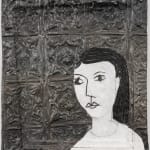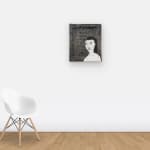ROBERT KOBAYASHI
She Grew Up in Front of Me, 2011
Ceiling tin, paint, nails on wood
22 x 18 3/4 x 2 in.
Copyright The Estate of Robert Kobayashi
Photo: Photo: Adam Reich, NYC
$ 40,000.00
Further images
Dad held his titles close to his chest. I’m sure I asked him, “Hey, was this one about me?” I am just as sure he waved off the question. He...
Dad held his titles close to his chest. I’m sure I asked him, “Hey, was this one about me?” I am just as sure he waved off the question. He hated thinking he was being interrogated about something but enjoyed books that were buried in obscure references and meanings.
From the outset, my father and I were so much alike that nursery school was an absolute non-negotiable because, in his words, “We’re going to kill each other.” Now, I see him in my personality more than ever, and it’s both funny and frustrating. The best parts of Dad could also be the most volatile. Both of our senses of humor are generous and eviscerating, while our stoicism can become simply coldness.
She Grew Up in Front of Me is the starkest portrait of myself—assuming that it is me and not giving in to dad’s insistence that titles are just titles—that might ever be made. The woman in it has a blank, far-off stare and an expression that strikes me as more numb than neutral. There is a tomb-like aspect to the background, and the texture of the tin feels ominous and sinister. I’ve always been uneasy with this work because of the year it was made and the dynamic with my dad I had at that point. Upon seeing it without a history attached, it’s mesmerizing because the subject is mesmerized.
In 2007, I ran headlong into a series of psychiatric problems. There were different triggers or fuses, but the culmination of that year was winding up in a hospital where my father and mother visited me every day, making a long trip uptown. While dad could be negligent in his clothing during the day or doing his work, he had an outstanding sense of propriety for most everything else. He showed up each day in his nicest trench coat, his black turtleneck, and pressed slacks. One of the aspects that remains so memorable is the good-natured rapport he had with the other patients, most of whom were interned in a temporary crisis period. Some of them took to saluting dad when they heard he was a veteran. I think that the dignity he took each time to dress up as though for a fancy event was immensely helpful for everyone else. I will never forget the feeling of looking down the hallway and seeing the familiar figure of him, hands in his pockets like Humphrey Bogart, and to all the world looking like he was just waiting at a crosswalk.
2009 was another crisis period for me, which was a longer stay at a different facility. My dad comported himself in the same way, though it was harder for him to understand how we’d gotten to this point. When I came back to live at home, it was never really mentioned again, but the sadness inherent in the work would imply that Dad saw something change in me that I hadn’t.
By 2011, life was remarkably straightened out. I had started going back to school, and I was working and paying my way through it. But perhaps it was the two years out from all the grief I’d given him that he needed to finally make something of the time we’d spent in turmoil as a family. The piece speaks to me differently during different eras; now it is a symbol of how well my father knew me and how well, with such clarity, he could see me.
- Misa Kobayashi
From the outset, my father and I were so much alike that nursery school was an absolute non-negotiable because, in his words, “We’re going to kill each other.” Now, I see him in my personality more than ever, and it’s both funny and frustrating. The best parts of Dad could also be the most volatile. Both of our senses of humor are generous and eviscerating, while our stoicism can become simply coldness.
She Grew Up in Front of Me is the starkest portrait of myself—assuming that it is me and not giving in to dad’s insistence that titles are just titles—that might ever be made. The woman in it has a blank, far-off stare and an expression that strikes me as more numb than neutral. There is a tomb-like aspect to the background, and the texture of the tin feels ominous and sinister. I’ve always been uneasy with this work because of the year it was made and the dynamic with my dad I had at that point. Upon seeing it without a history attached, it’s mesmerizing because the subject is mesmerized.
In 2007, I ran headlong into a series of psychiatric problems. There were different triggers or fuses, but the culmination of that year was winding up in a hospital where my father and mother visited me every day, making a long trip uptown. While dad could be negligent in his clothing during the day or doing his work, he had an outstanding sense of propriety for most everything else. He showed up each day in his nicest trench coat, his black turtleneck, and pressed slacks. One of the aspects that remains so memorable is the good-natured rapport he had with the other patients, most of whom were interned in a temporary crisis period. Some of them took to saluting dad when they heard he was a veteran. I think that the dignity he took each time to dress up as though for a fancy event was immensely helpful for everyone else. I will never forget the feeling of looking down the hallway and seeing the familiar figure of him, hands in his pockets like Humphrey Bogart, and to all the world looking like he was just waiting at a crosswalk.
2009 was another crisis period for me, which was a longer stay at a different facility. My dad comported himself in the same way, though it was harder for him to understand how we’d gotten to this point. When I came back to live at home, it was never really mentioned again, but the sadness inherent in the work would imply that Dad saw something change in me that I hadn’t.
By 2011, life was remarkably straightened out. I had started going back to school, and I was working and paying my way through it. But perhaps it was the two years out from all the grief I’d given him that he needed to finally make something of the time we’d spent in turmoil as a family. The piece speaks to me differently during different eras; now it is a symbol of how well my father knew me and how well, with such clarity, he could see me.
- Misa Kobayashi









